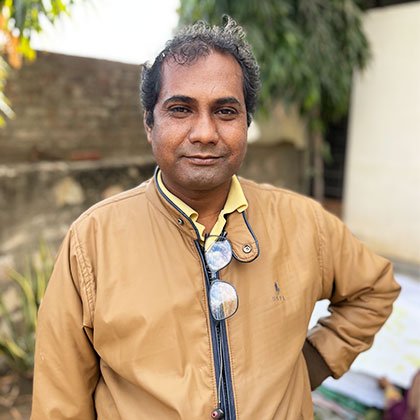Shravan's Paper Workshop
The craft of making paper by hand has a long history in Rajasthan, dating back to the 1520s. Chinese craftsmen had already developed a method by the second century which has changed very little over time and involves diluting cellulose fibres in water to make a pulp. Whilst bamboo, local plants, or even scraps of fishing nets might have previously been used, artisans in India use rags from the garment industry.
All our hang tags are made this way and then individually printed by hand.
Handmade paper is beautiful and tree-free. The process of making our paper gives it a tactile texture that a machine could not replicate.
Cotton rags are beaten and shredded reducing the waste to a pulp, to extract cellulose fibre, a key component of paper. The rags fray, resulting in tiny fibres. When mixed with water, they interlock, creating a strong and flexible surface.



Big trays of fine brass or stainless steel mesh are stretched around a wooden frame and submerged in water to collect the pulp from the bottom of the tanks. The frame is lifted, shaken and drained, leaving a uniform layer of paste on the screen. The size of the area inside the frame, dictates the size of each resulting sheet.
The artisans cover the wet fibre sheet with a layer of muslin. They repeat the process, and once they have completed the required number of sheets a, the pile is pressed to drive out any excess water left. The sheets are then peeled off the muslin and left to air dry.



The paper is completely made by hand, one sheet at a time.
Once the paper is ready, the hand-printing of our tags can begin. Screen printing is one of the oldest methods of printing. A screen of mesh is mounted tightly on a frame. Parts of the screen are blocked to form a stencil in the negative image of the motif to be printed, then go through a process to make those areas impermeable. A squeegee is moved across the screen to fill the unblocked mesh sections with ink, forcing it through those open areas onto paper. One colour is printed at a time, so when printing our two-tone logo, the artisan needs to reposition the screen accurately over the first colour and then print the second colour on top.




During winter and the monsoon, the paper-making process slows down as drying can take up to five days.
Seeds can be added to the pulp when it is mixed with water, creating paper that can be planted in soil to grow flowers. Sometimes Shravan and his team place leaves and flowers between finished sheets of paper, which then go through a press to create a beautiful impression. The leaves are then removed and discarded.




SHRAVAN, workshop owner
Papermaking has been a family business for three generations. Shravan's father and grandfather, who initially came from a farming background, worked for a big government paper factory in Sanganer, where they learned this craft. His grandfather was the first in the family to set up a company, building it from the ground up. Shravan was sixteen when he learned this craft from his father. From a young age he wanted to continue growing the family's business. It is obvious how proud he is of his family's legacy and his own work, and we are delighted to be working with him on some of our branding.

